Design of Radial Flow Channel Proton Exchange Membrane Fuel Cell Based on Topology Optimization
Abstract
:1. Introduction
2. Materials and Methods
2.1. Model Assumptions
- Research environment in steady-state, constant temperature, and laminar flow states;
- Oxygen is a compressible gas at the inlet;
- The single-phase weighted mixture model is adopted. Simplify water management issues due to the smaller height of each layer [18];
- Porous medium is isotropic and has uniform porosity;
- The membrane does not allow the permeation of reactive gases;
- If the influence of water is added, the convergence of topology optimization will be more complex, and the computational complexity will also be more significant. For simplicity, we neglect the water transport through the membrane;
- It is assumed that the reactant gas behaves as an ideal gas.
2.2. Simplified Model of Average Depth Model
2.2.1. Conservation of Mass and Momentum
2.2.2. Conservation of Species
2.2.3. Reaction Kinetics
2.3. Topological Optimization
2.3.1. Material Modeling and Regularization
2.3.2. Objective Function and Constraints
2.3.3. TOM Process
- (a)
- Define conservation of mass and momentum (Brinkman equation);
- (b)
- Define the transport of species (O2, H2O, N2);
- (c)
- Define reaction kinetics (Butler–Volmer) and local current density;
- (d)
- Solve the state equations coupled (Steps a, b, c);
- (e)
- Calculate the sensitivities of objective functions and constraints (Adjoint Method);
- (f)
- Update the design variable value () with an optimization algorithm (SNOPT);
- (g)
- Verify the stopping criteria.
3. Results
3.1. Model Validation
3.2. Design of Radial Flow Channel Model
3.2.1. Model Optimization Analysis
3.2.2. Velocity Field Analysis after TOM
3.2.3. Oxygen Concentration Analysis after TOM
3.2.4. Water Concentration Analysis after TOM
3.2.5. Analysis of Polarization Curve after TOM
3.2.6. TOM Post-Processing and Model Verification
4. Conclusions
- (1)
- Increasing the maximum volume constraint is beneficial for obtaining a complete topology model, enhancing the uniformity of oxygen distribution, and improving drainage performance.
- (2)
- The optimized radial PEMFC has higher voltage and power output than parallel and serpentine channels at medium to high current densities. Increasing the maximum volume constraint is beneficial for improving the cell performance of PEMFC. However, after the maximum volume constraint exceeds 40%, the cell performance difference of PEMFC is relatively small, and the topology has reached the optimal treatment of minimizing PEMFC power loss. Increasing the maximum volume constraint can reduce the energy loss of the gas, but it has little impact on the cell performance of PEMFC. Among all optimization schemes, Scheme 4 has a tremendous advantage.
- (3)
- By comparing the 3D model and 2D model under the same conditions, it is found that the model optimized by topological can accurately reflect the horizontal electrochemical reaction of the 3D model but cannot reflect the vertical change in PEMFC.
Author Contributions
Funding
Data Availability Statement
Conflicts of Interest
References
- Bunyan, S.T.; Dhahad, H.A.; Khudhur, D.S.; Yusaf, T. The effect of flow field design parameters on the performance of PEMFC: A review. Sustainability 2023, 15, 10389. [Google Scholar] [CrossRef]
- Shang, Z.H.; Hossain, M.M.; Wycisk, R.; Pintauro, P.N. Poly(phenylene sulfonic acid)-expanded polytetrafluoroethylene composite membrane for low relative humidity operation in hydrogen fuel cells. J. Power Sources 2022, 535, 231375. [Google Scholar] [CrossRef]
- Linden, F.V.; Pahon, E.; Morando, S.; Bouquain, D. A review on the Proton-Exchange Membrane Fuel Cell break-in physical principles, activation procedures, and characterization methods. J. Power Sources 2023, 575, 233168. [Google Scholar] [CrossRef]
- Ibhadode, O.; Zhang, Z.D.; Sixt, J.; Nsiempba, K.M.; Orakwe, J.; Martinez-Marchese, A.; Ero, O.; Shahabad, S.I.; Bonakdar, A.; Toyserkani, E. Topology optimization for metal additive manufacturing: Current trends, challenges, and future outlook. Virtual Phys. Prototyp. 2023, 18, 2181192. [Google Scholar] [CrossRef]
- Golecki, T.; Gomez, F.; Carrion, J.; Spencer, B.F. Bridge topology optimization considering stochastic moving traffic. Eng. Struct. 2023, 292, 116498. [Google Scholar] [CrossRef]
- Gomesl, P.; Palacios, R. Aerostructural topology optimization using high fidelity modeling. Struct. Multidiscip. Optim. 2022, 65, 137. [Google Scholar] [CrossRef]
- Wang, J.P.; Wu, J.; Westermann, R. Stress topology analysis for porous infill optimization. Struct. Multidiscip. Optim. 2022, 65, 92. [Google Scholar] [CrossRef]
- Gomes, P.; Palacios, R. Aerodynamic-driven topology optimization of compliant airfoils. Struct. Multidiscip. Optim. 2020, 62, 2117–2130. [Google Scholar] [CrossRef]
- Pollini, N. Topology optimization of wind farm layouts. Renew. Energy 2022, 195, 1015–1027. [Google Scholar] [CrossRef]
- Li, Q.Q.; Cao, G.L.; Zhang, X.W.; Li, G.J. Topology optimization of the microstructure of solid oxide fuel cell cathodes. Acta Mater. 2020, 201, 278–285. [Google Scholar] [CrossRef]
- Yang, D.J.; Hao, Y.; Li, B.; Ming, P.W.; Zhang, C.M. Topology optimization design for the lightweight endplate of proton exchange membrane fuel cell stack clamped with bolts. Int. J. Hydrogen Energy 2022, 47, 9680–9689. [Google Scholar] [CrossRef]
- Wang, H.; Wang, Z.L.; Zhu, J.H.; Zhang, W.H.; Ming, P.W. Thermal-fluid-structural topology optimization of coolant channels in a proton exchange membrane fuel cell. Int. Commun. Heat Mass Transfer 2023, 142, 106648. [Google Scholar] [CrossRef]
- Behrou, R.; Pizzolato, A.; Forner-Cuenca, A. Topology optimization as a powerful tool to design advanced pemfcs. Int. J. Heat Mass Transfer 2019, 135, 72–92. [Google Scholar] [CrossRef]
- Liu, F.; Kvesic, M.; Wippermann, K.; Reimer, U.; Lehnert, W. Effect of spiral flow field design on performance and durability of HT-PEFCs. J. Electrochem. Soc. 2013, 160, 892–897. [Google Scholar] [CrossRef]
- Lu, J.Z.; Xia, Y.Z.; Hu, Y.W.; Wang, Z.C.; Lei, H.W.; Hu, G.L. Study on transport phenomena and performance of proton exchange membrane fuel cell with radial flow fields. Eng. Appl. Comput. Fluid Mech. 2023, 17, 2156925. [Google Scholar] [CrossRef]
- Xie, Q.Z.; Zheng, M.G. CFD Simulation and Performance Investigation on a Novel Bionic Spider-Web-Type Flow Field for PEM Fuel Cells. Processes 2021, 9, 1526. [Google Scholar] [CrossRef]
- Comsol Multiphysics, v. 5.3a; Comsol Ab: Stockholm, Sweden, 2017. Available online: www.comsol.com(accessed on 14 December 2017).
- Wang, C.; Zhang, Q.L.; Shen, S.Y.; Yan, X.H.; Zhu, F.J.; Cheng, X.J.; Zhang, J.L. The respective effect of under-rib convection and pressure drop of flow fields on the performance of pem fuel cells. Sci. Rep. 2017, 7, 43447–43455. [Google Scholar] [CrossRef] [PubMed]
- Olesen, L.H.; Okkels, F.; Bruus, H. A high-level programming-language implementation of topology optimization applied to steady-state navier–stokes flow. Int. J. Numer. Methods Eng. 2006, 65, 975–1001. [Google Scholar] [CrossRef]
- O’hayre, R.P.; Cha, S.W.; Colella, W.G.; Prinz, F.B. Fuel Cell Fundamentals; John Wiley & Sons: New York, NY, USA, 2016. [Google Scholar]
- Kee, R.J.; Coltrin, M.E.; Glarborg, P. Chemically Reacting Flow: Theory and Practice; John Wiley & Sons: New York, NY, USA, 2005. [Google Scholar]
- Cussler, E.L. Diffusion: Mass Transfer in Fluid Systems; Cambridge University Press: Cambridge, UK, 2009. [Google Scholar]
- Sun, L.; Shen, J.; Hua, Q.S.; Lee, K.Y. Data-driven oxygen excess ratio control for proton exchange membrane fuel cell. Appl. Energy 2018, 231, 866–875. [Google Scholar] [CrossRef]
- Alexandersen, J.; Aage, N.; Andreasen, C.S.; Sigmund, O. Topology optimization for natural convection problems. Int. J. Numer. Methods Fluids 2014, 76, 699–721. [Google Scholar] [CrossRef]
- Lazarov, B.S.; Sigmund, O. Filters in topology optimization based on helmholtz-type differential equations. Int. J. Numer. Methods Eng. 2011, 86, 765–781. [Google Scholar] [CrossRef]
- Wang, F.W.; Lazarov, B.S.; Sigmund, O. On projection methods, convergence and robust formulations in topology optimization. Struct. Multidiscip. Optim. 2011, 43, 767–784. [Google Scholar] [CrossRef]
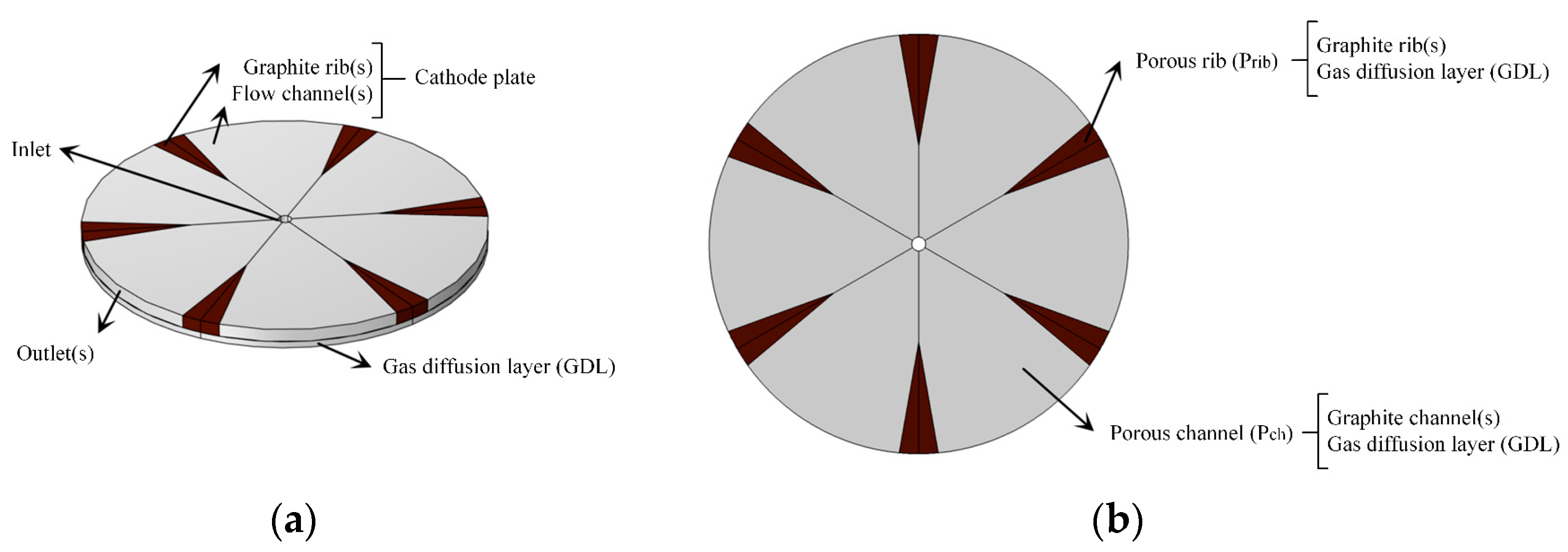


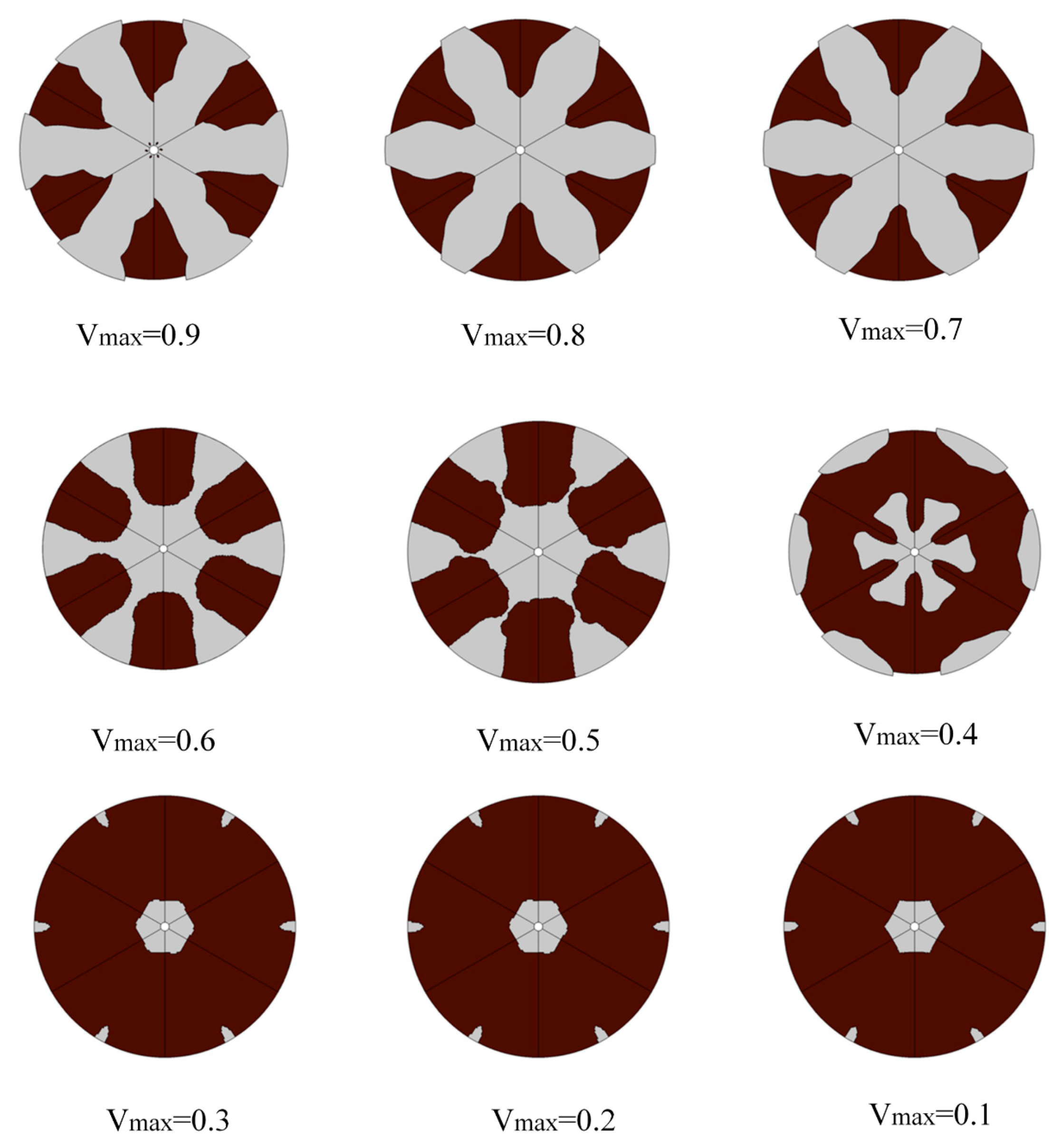
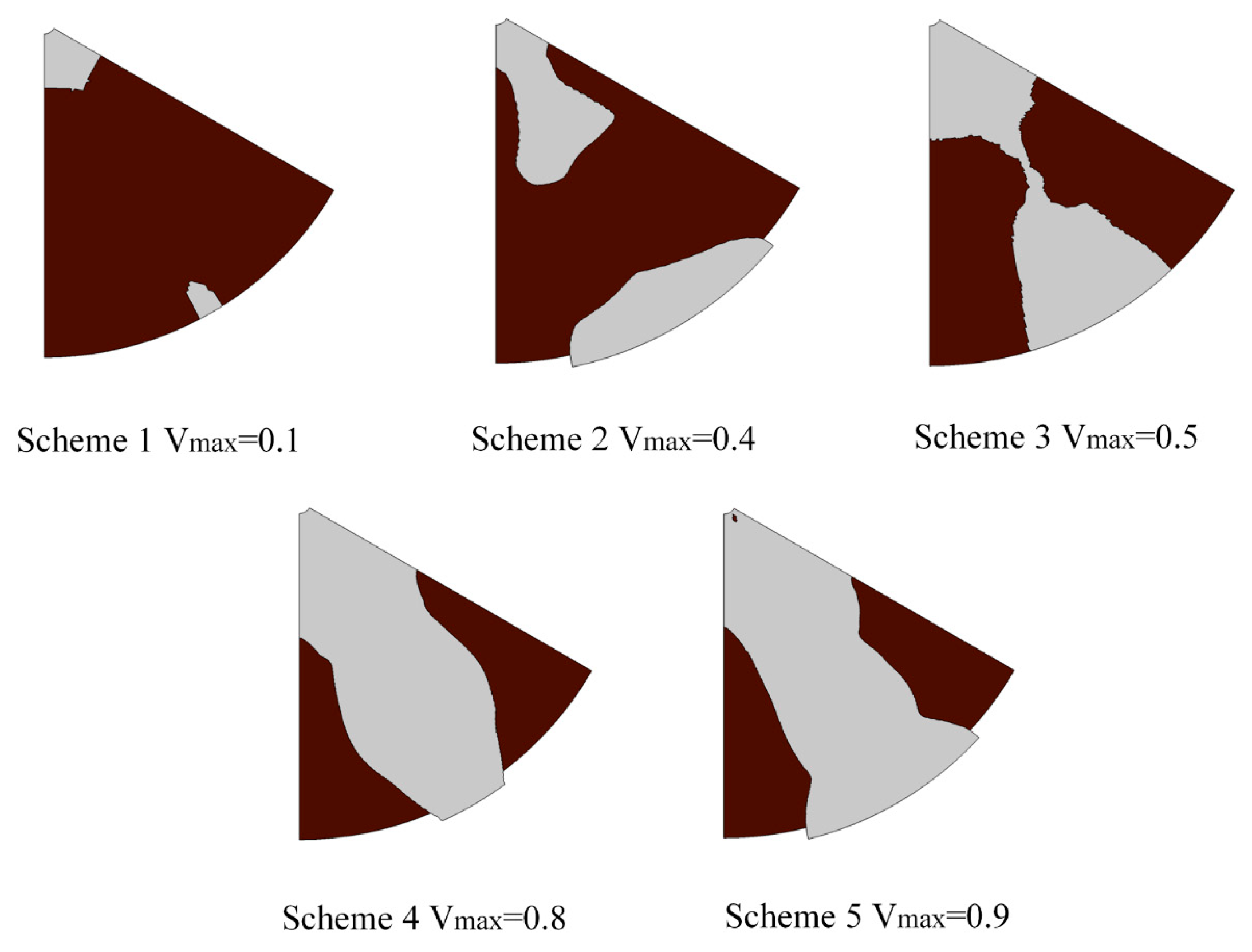
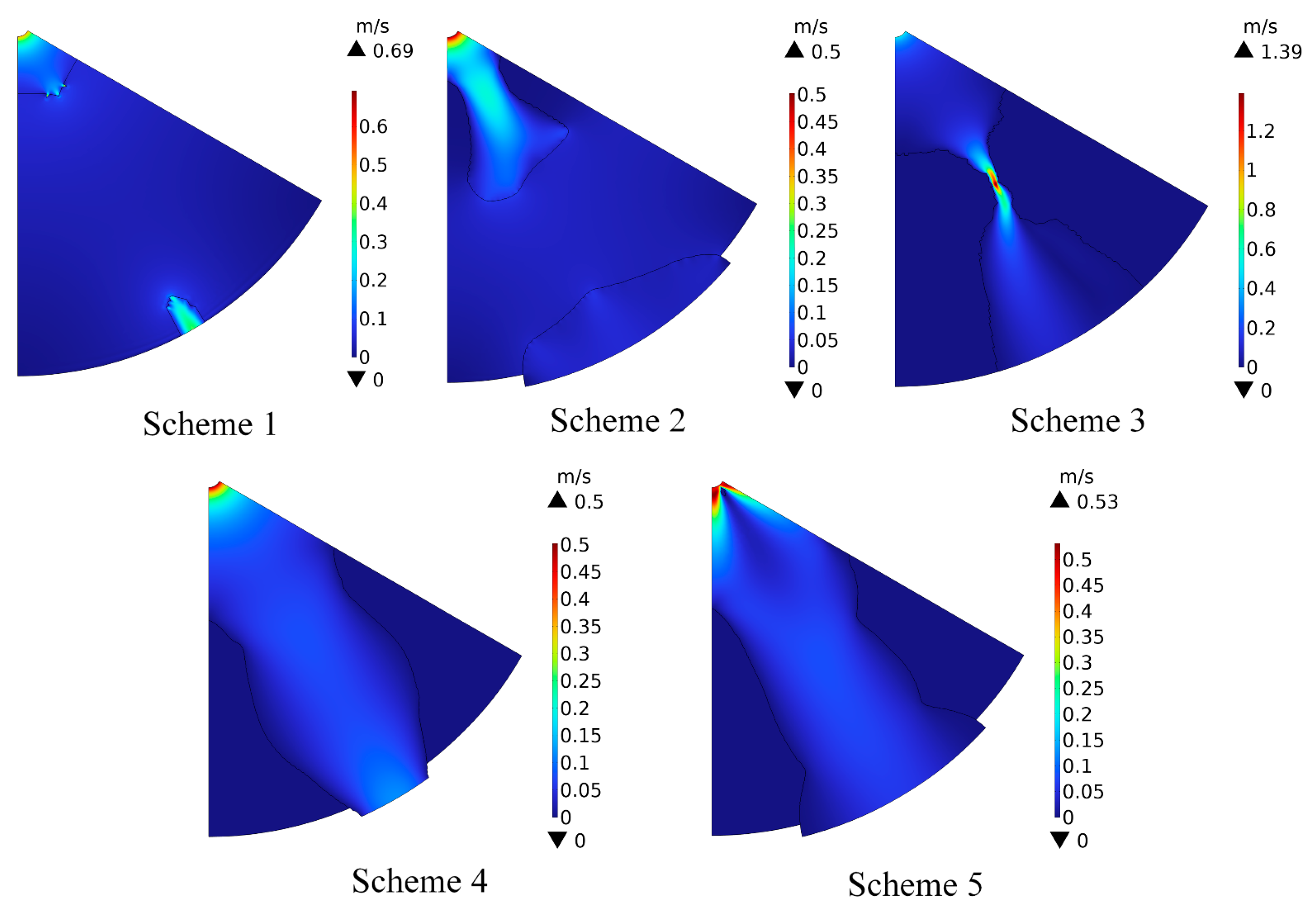
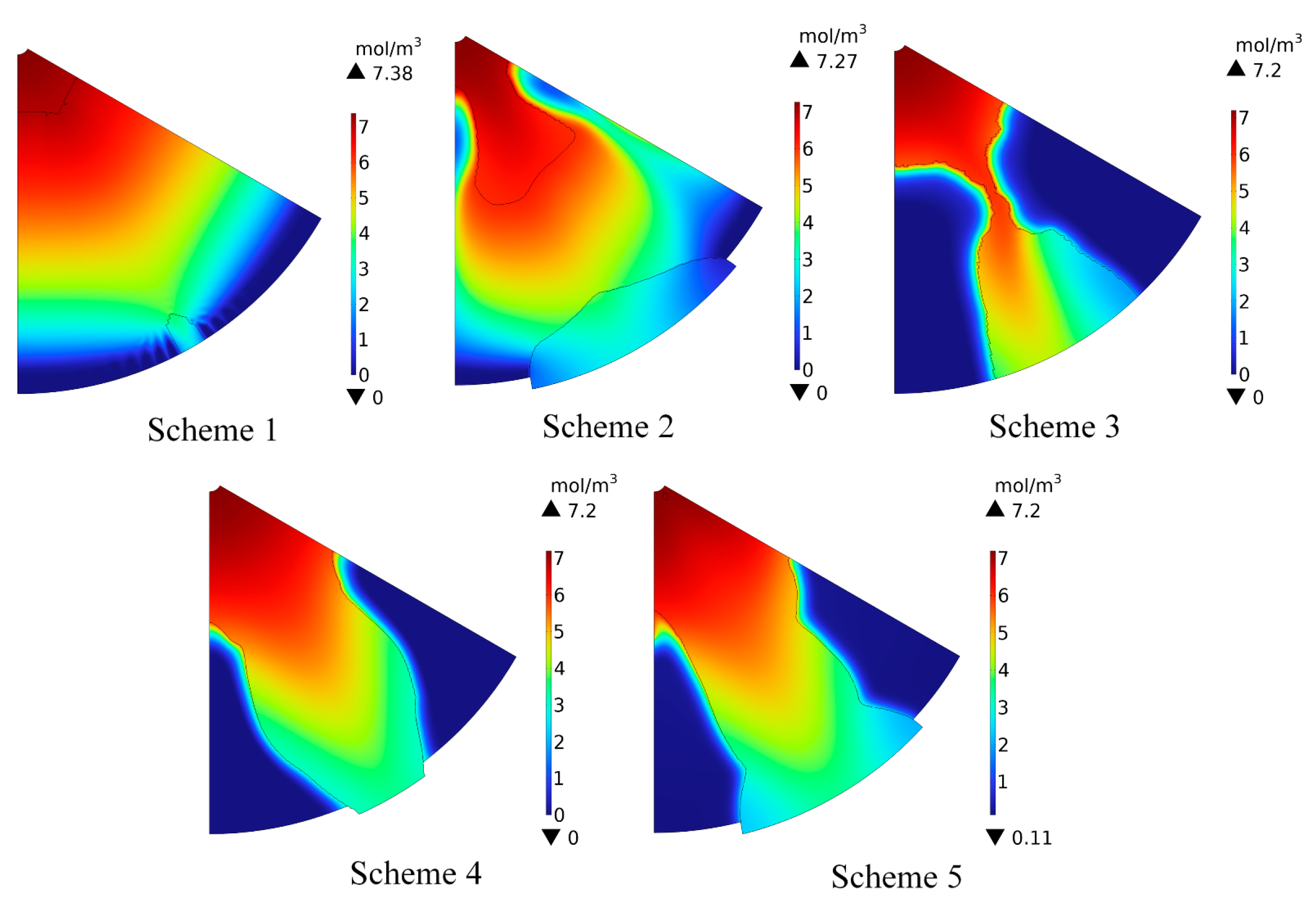
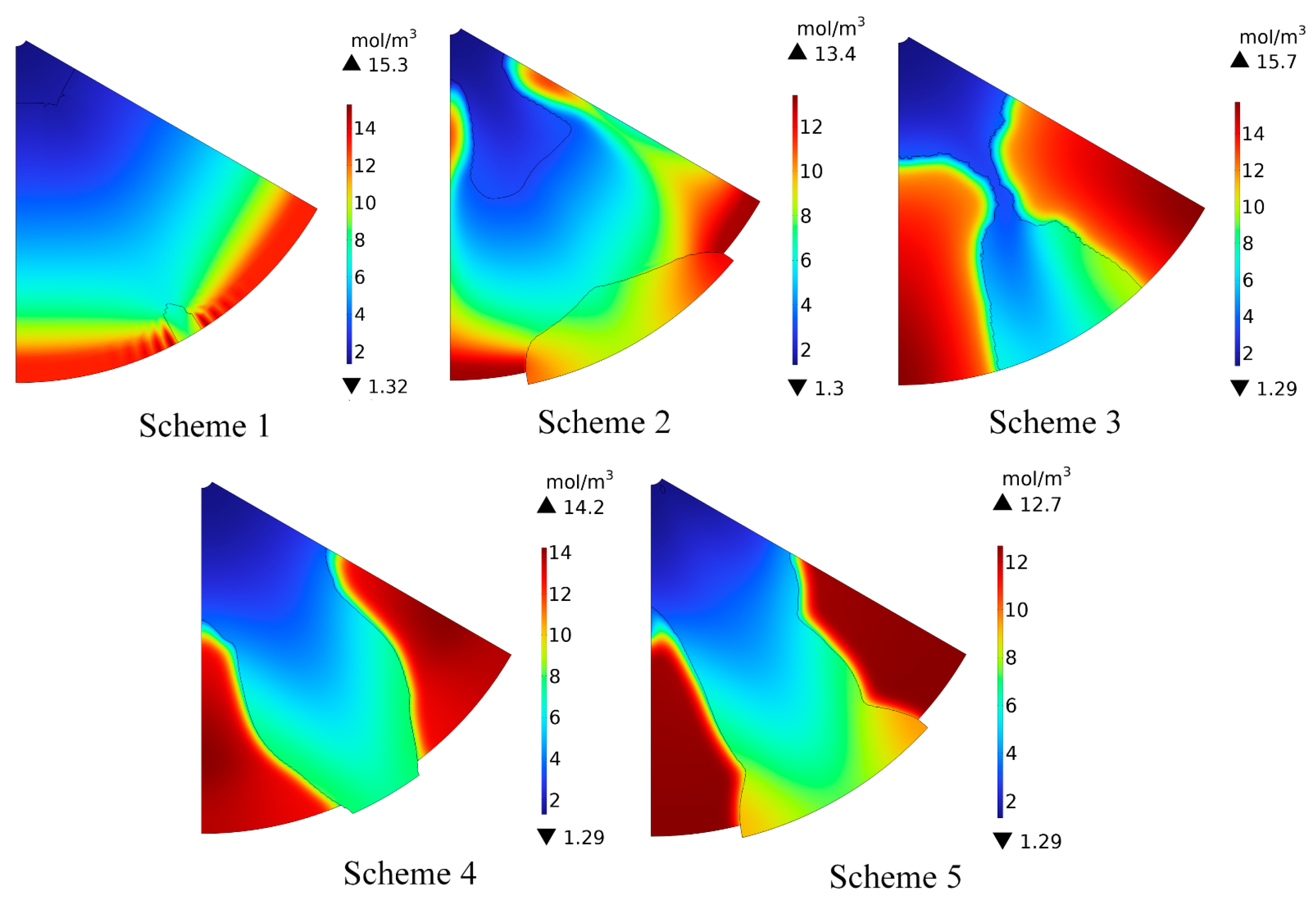



| Parameter | Value |
|---|---|
| Inlet radius of flow channel | /m |
| Outlet radius of flow channel | /m |
| Flow channel height | /m |
| GDL height | /m |
| Sector design domain angle | 60/deg |
| PEMFC working voltage | 0.6/V |
| PEMFC open-circuit voltage | 1.23/V |
| PEMFC temperature T | 343.15/K |
| Reference temperature | 298.15/K |
| Reference pressure | 1/atm |
| Lumped resistance | / |
| Inlet velocity | 0.5/m s−1 |
| Permeability of GDL | / |
| Porosity of GDL | 0.8 |
| Entrance oxygen mass fraction | 0.228 |
| Entrance water mass fraction | 0.023 |
| Entrance nitrogen mass fraction | 0.749 |
| Oxygen reference concentration | 30/mol m−3 |
| Cathode transfer coefficient | 0.5 |
| Exchange current density | 0.17/A m−2 |
| Number of species | 3 |
| Number of electrons | 4 |
| Water molar mass | 0.018/kg mol−1 |
| Nitrogen molar mass | 0.028/kg mol−1 |
| Oxygen molar mass | 0.032/kg mol−1 |
| Water chemometric coefficient | 2 |
| Nitrogen chemometric coefficient | 0 |
| Oxygen chemometric coefficient | −1 |
| Oxygen diffusion coefficient in water | /m2 s−1 |
| Nitrogen diffusion coefficient in water | /m2 s−1 |
| Oxygen diffusion coefficient in nitrogen | /m2 s−1 |
| Equivalent permeability (porous ribs) | /m2 |
| Equivalent permeability (porous channels) | |
| Equivalent porosity (porous ribs) | 0.22029 |
| Equivalent porosity (porous channels) | 0.94493 |
| Equivalent diffusion coefficient (porous ribs) | 0.19703 |
| Equivalent diffusion coefficient (porous channels) | 0.92167 |
| Dynamic viscosity | /Pa s |
| Reactive gas density | 1/kg m−3 |
| Universal gas constant | 8.3144/J mol−1 k−1 |
| Faraday constant (constant) | 96,485.3/C mol−1 |
| Parameter | Value |
|---|---|
| Convex factor q | |
| Penalty factor | |
| Filter radius | /m |
| Projection slope | |
| Projection point | 0.5 |
| Initial value of control variable | 0.5 |
| Maximum volume fraction | 0.1, 0.2, 0.3, 0.4, 0.5, 0.6, 0.7, 0.8, 0.9 |
| Optimum tolerance | |
| Maximum number of model evaluations | 5000 |
| Internal tolerance factor | 0.001 |
| Constrained penalty factor | |
| Maximum internal iteration | 10 |
Disclaimer/Publisher’s Note: The statements, opinions and data contained in all publications are solely those of the individual author(s) and contributor(s) and not of MDPI and/or the editor(s). MDPI and/or the editor(s) disclaim responsibility for any injury to people or property resulting from any ideas, methods, instructions or products referred to in the content. |
© 2023 by the authors. Licensee MDPI, Basel, Switzerland. This article is an open access article distributed under the terms and conditions of the Creative Commons Attribution (CC BY) license (https://creativecommons.org/licenses/by/4.0/).
Share and Cite
Qu, C.; Zhang, Y.; Zhang, Z.; Zheng, M. Design of Radial Flow Channel Proton Exchange Membrane Fuel Cell Based on Topology Optimization. Processes 2023, 11, 2482. https://doi.org/10.3390/pr11082482
Qu C, Zhang Y, Zhang Z, Zheng M. Design of Radial Flow Channel Proton Exchange Membrane Fuel Cell Based on Topology Optimization. Processes. 2023; 11(8):2482. https://doi.org/10.3390/pr11082482
Chicago/Turabian StyleQu, Cheng, Yifan Zhang, Zhihu Zhang, and Minggang Zheng. 2023. "Design of Radial Flow Channel Proton Exchange Membrane Fuel Cell Based on Topology Optimization" Processes 11, no. 8: 2482. https://doi.org/10.3390/pr11082482
APA StyleQu, C., Zhang, Y., Zhang, Z., & Zheng, M. (2023). Design of Radial Flow Channel Proton Exchange Membrane Fuel Cell Based on Topology Optimization. Processes, 11(8), 2482. https://doi.org/10.3390/pr11082482






